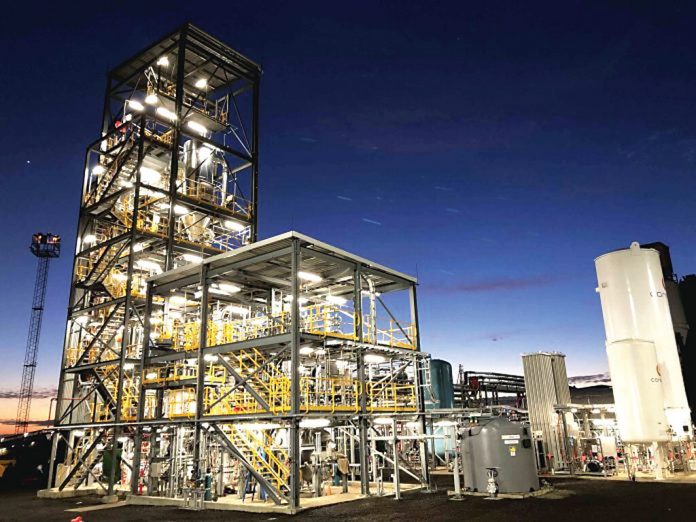
PHILIP HOPKINS
By PHILIP HOPKINS
AGL has unveiled its long-term aim to turn the Loy Yang A power station site into a low-carbon Energy Hub featuring solar materials and battery recycling, grid-scale batteries, potential hydrogen production and advanced manufacturing. The company’s plans for the Latrobe Valley Energy Hub were outlined at an event at Loy Yang recently, attended by more than 100 people, including the Minister for Energy, Lily D’Ambrosio, members of Latrobe City Council, and local community and business groups. AGL’s chief operating officer, Markus Brokhof, said given the early closure of Loy Yang A in 2035, the company had begun to plan what the future of the Latrobe Valley Energy Hub would look like. “This involves dialogue with relevant stakeholders and industrial partners,” he said. “Loy Yang is a fantastic site with a skilled local workforce and established infrastructure. Over the coming decade, we will work together with partners to explore a range of options including wind and solar power, grid-scale batteries, hydrogen production and co-location with advanced manufacturing industries.” Mr Brokhof said AGL had recently signed a memorandum of understanding (MOA) with Solar Recovery Corporation to explore establishing a solar panel materials recovery plant at the site. “This would enable remanufacture of solar panel materials at the end of their life,” he said. “This is typical of industrial partners we have invited here and other people from the renewables industry.” Around the site, Mr Brokhof said AGL was looking to establish a solar and thermal storage project terminal and storage plant. AGL already had a shareholding in a pilot project near Mildura that it would like to commercialise at the Loy Yang site. AGL and Australian energy technology group RayGen have built a $27 million pilot solar and thermal storage project at Carwarp, about 20 minutes south of Mildura. The plant uses a combination of RayGen’s solar and hydro technology to produce 24-hour renewable electricity that AGL says is low-cost. The system is powered by a field of smart, rotational mirrors whose concentrated solar energy is combined with the energy stored across two water reservoirs to create a ‘hot and cold’ solar hydro solution. The Carwarp plant delivers four megawatts (MW) of solar generation and 50 megawatt hours (MWh) of storage to produce electricity on demand. AGL says this improves grid stability, as well as supplying reliable, synchronous power. AGL committed $5 million to help fund the construction at Carwarp as well as agreeing to offtake the entirety of the plant’s production. Mr Brokhof said the official inauguration of the project would take place at the end of this month in Mildura. He said advanced manufacturing projects were also planned for the Loy Yang site. “There are a lot of things in the pipeline that I can’t disclose now. We are looking at all the technologies – at battery recycling, waste-to-energy – all these efforts and partnerships would add value to our site,” he said. Mr Brokhof said AGL did not plan to just build solar or wind plants. “We are taking a different approach – we look at our customers and the customer needs and build an ecosystem of low carbon energy production around them. We are not just building on site; we ask the customer,” he said. “That is the reason why we are planning early with engagement 12 years ahead of the closure of Loy Yang. We need a planning horizon to build infrastructure around this.” Mr Brokhof said AGL had already signalled that it would build an initial 200MW battery at Loy Yang. The company would decide next year, when a financial investment decision would be made, about further generation capacity in the context of the entire energy infrastructure, he said. Mr Brokhof said the Japanese HESC coal-to-hydrogen project – the plant is located next to the Loy Yang power station – was going through the feasibility stage for a commercial plant. “There is a great opportunity. The Japanese Government supports the HESC project, with more than $2 billion funding. The Japanese parent is looking at the theoretical funding requirements from the federal and state governments,” he said. The HESC project would require continual mining of the Loy Yang site. “This requires separate approval; it is not covered by the current mining licence. Once we start the evaluation phase and engineering design, we need to apply for different licences,” he said. Mr Brokhof emphasised that AGL would continue to redevelop the site over the next few years. “We don’t want to disappear from the site, demolish the plant and leave. We want to build an energy structure on the site and transition our people. We are transparent with our workers. The aim is to create employment for the next generation on the site,” he said. “We are also looking at Indigenous projects, recognise the need to give back to the Gunaikurnai people, the traditional owners of the land.” Mr Brokhof said the Loy Yang plans formed a part of AGL’s broader transition strategy to transform the Liddell and Bayswater sites in NSW into the Hunter Energy Hub and the Torrens site in South Australia into the Torrens Energy Hub. “At the Torrens hub, a 250MW battery will soon be operational and at the Hunter hub, planning permission has been granted for the 500MW Liddell battery,” he said. RayGen has received support from the Australian Renewable Energy Agency (ARENA) for the Carwarp site. RayGen’s chief executive, Richard Payne, said AGL had agreed three years ago to provide a ‘voice of customer’ into the design process for RayGen’s storage product. “AGL provided valuable insights that enhanced our technology offering, and AGL is now supporting deployment with an offtake and investment,” Mr Payne said. Both companies have worked on the design of the $27 million concentrated solar and thermal storage site since 2019.









